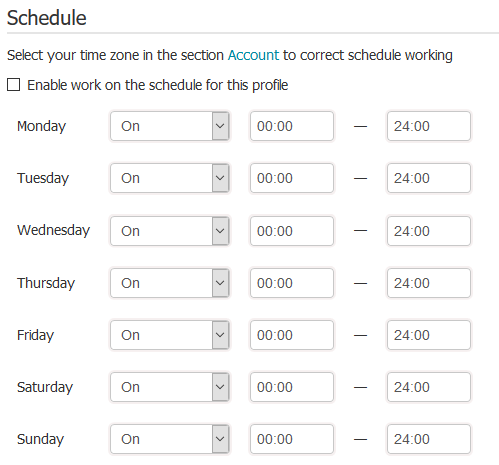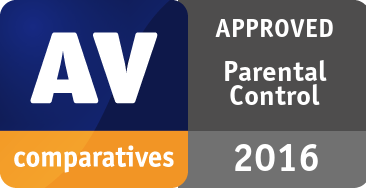
Parental Control Review 2016 – SafeDNS
Parental Control Test October 2016
| Release date | 2016-10-26 |
| Revision date | 2016-10-24 |
| Test Period | October 2016 |
| Number of Testcases | 2000 |
| Online with cloud connectivity |  |
| Update allowed |  |
| False Alarm Test included |  |
| Platform/OS | Microsoft Windows |
Introduction
Parental control software allows parents to filter out websites that their children can see, in order to avoid the children being exposed to materials the parents consider unsuitable, such as pornography, gambling or weapons.
SafeDNS provides parents with fine-grained control over which website categories their children may access. Parents may define three different protection profiles, which can be used to protect children of different age groups, for instance. Statistics about their children’s internet activities can be obtained from the web interface. Furthermore, parents can create schedules to define when their children may use the internet. SafeDNS can be set up on the home network’s gateway router, protecting all devices within the network without the need to install additional client software.
According to SafeDNS’ website, the service also includes general internet security features such as ad-blocking, and protection against malware and botnets. Tests of these features are not included in this report however, as the report focusses on features specific to parental control.
During our test, SafeDNS achieved a good block rate for websites containing pornographic content. Relatively few gambling and weapon related websites were blocked by the service. Since protection for mobile devices is currently in its beta stage and does not provide adequate parental control mechanisms yet, these versions are excluded from our parental control certification.
This report has been commissioned by SafeDNS.
Tested Products
Test Procedure
We tested the effectiveness of the parental control software against 2,000 websites with potentially inappropriate content for children. We chose the appropriate settings for a 9-year-old girl. Additionally, the category “weapons” was enabled in SafeDNS.
Testcases
The 2000 URLs were broken down as follows:
- Pornography: 1,600 sites displaying pornographic images and text
- Gambling: 200 sites which allow online betting
- Weapons: 200 sites selling or advertising weapons online
We additionally tested 50 obviously child-friendly websites, such as lego.com, to check for false positives.
Test Results
| Block Rate | |
| Adult | 98,4% |
| Gambling | 51% |
| Weapons | 18% |
| False-Positives | 0 |

Product Reviews

About the product
SafeDNS provides an internet safety service, which can be used as parental control software in order to prevent children from accessing dangerous websites. Since SafeDNS’ services are cloud-based, parents can configure protection settings centrally, using a web management console.
Version tested
SafeDNS 2.6.3.0
Supported operating systems
SafeDNS provides platform-independent protection, when configured on a gateway server or router.
For individual devices:
Windows XP SP3 and later
Android, iOS
Parental control features
- Web content filtering
- Internet usage schedules
- Restricted search engine usage
- Restricted Youtube mode
Web filtering Categories

The web interface also allows parents to block all pages not found in SafeDNS’ domain database. While this option certainly leads to better protection, it also increases the amount of blocked safe websites.
Restricted search
The product includes safe search features compatible with Google and Bing. If safe search is activated, explicit content will be removed from the search results of those search engines. Apart from enforcing safe search, also Youtube’s restricted mode can be enforced by the service. In restricted mode, children will not be able to view age-restricted videos or view video comments.
Blacklisting/whitelisting
Blacklists and whitelists can be configured in the web interface. There is an option to allow the whitelist only, i.e. to block any sites that are not on it.
Using Google as a bypass
If Proxies and Anonymizers is selected, it is not possible to use Google Translate or the Google cache.
Time limits
Time limits can be set for Internet use using the web interface:

What does the child see when a page is blocked?

The web interface also allows parents to customize the displayed block pages.
What details are available?
Clicking Show details displays the URL of the site blocked, along with the category to which it has been assigned:
 Help
Help
Installation guides are available to download from the vendor’s website, and there is an FAQ page: https://www.safedns.com/en/faq
SafeDNS for Windows

Setup
To install the SafeDNS agent on a Windows computer, the user creates an online account on the vendor’s website, then downloads and runs a 6 MB installer file. The setup wizard allows the user to change the location of the installation folder, but otherwise installation is very simple with no choices to be made. The categories to be filtered can be configured online by logging in to the website.
In order to use SafeDNS as a parental control program, parents should take care not to let their children use a Windows account with administrative privileges, as an administrator can disable web filtering by setting a different DNS server in the network adapter settings. Another possibility would be to configure SafeDNS on the home network’s router instead.
Verdict
We found SafeDNS to be straightforward to set up and configure. The configuration options featured in the program provide parents with fine-grained control over blocked and allowed websites.
SafeDNS for Mobile Devices (currently in Beta)
To setup SafeDNS on an individual Android or iOS device, the user first needs to create a VPN on the Networks page of the web interface. When the VPN is created, the user can specify which profile should be applied to the new network. The user then needs to download the VPN certificate of the new network onto the device to be protected – either by directly copying the certificate to the devices’ SD card or by sending it via email. The downloaded certificate can then be opened using the free OpenVPN app. After connecting to the VPN using the OpenVPN app, the web-filter is active.
However, this setup is inadequate as a parental control mechanism, as protection can be disabled by simply disconnecting from the VPN. A more suitable method for parental control is to enable SafeDNS on the home network’s router, which still does not account for internet usage via mobile data services, however. As stated on the vendor’s website, the mobile filtering option is still in its beta stage, so SafeDNS might provide a better solution in the future.
Award levels reached in this Parental Control Review
AV-Comparatives provides certification for parental control software. In order to be certified, a product must block at least 98% of pornographic websites, have zero or only few false alarms on child-friendly websites and have no severe unresolved bugs discovered during the review. A certification is valid for one year and vendors can apply for certification once a year.
SafeDNS for Windows reached the above requirements and therefore get the AV-Comparatives Approved Parental Control award.

| SafeDNS | APPROVED |
Copyright and Disclaimer
This publication is Copyright © 2016 by AV-Comparatives ®. Any use of the results, etc. in whole or in part, is ONLY permitted after the explicit written agreement of the management board of AV-Comparatives prior to any publication. AV-Comparatives and its testers cannot be held liable for any damage or loss, which might occur as result of, or in connection with, the use of the information provided in this paper. We take every possible care to ensure the correctness of the basic data, but a liability for the correctness of the test results cannot be taken by any representative of AV-Comparatives. We do not give any guarantee of the correctness, completeness, or suitability for a specific purpose of any of the information/content provided at any given time. No one else involved in creating, producing or delivering test results shall be liable for any indirect, special or consequential damage, or loss of profits, arising out of, or related to, the use or inability to use, the services provided by the website, test documents or any related data.
For more information about AV-Comparatives and the testing methodologies, please visit our website.
AV-Comparatives
(October 2016)






